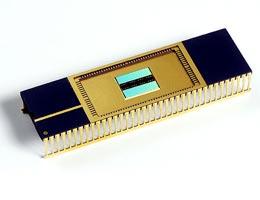 Is phase-change memory about to appear in your mobile phone?Samsung
Is phase-change memory about to appear in your mobile phone?SamsungSouth Korean manufacturer Samsung Electronics announced this week that it has begun mass production of a new kind of memory chip that stores information by melting and freezing tiny crystals. Known as phase-change memory (PCM), the idea was first proposed by physicists in the 1960s. Here, Nature explains how PCM works, why it has taken so long to develop and how it could change your mobile phone forever.
What's the big idea behind PCM?
PCM was first proposed by physicist and inventor Stanford Ovshinsky in 19681. It rests on a simple concept: atoms that are neatly arranged in crystals conduct electrons better than those jumbled up in a glass. Using the crystal form as a binary '1' and the glass form as '0' it is possible to store electronic information in a crystalline cell. Many such cells, Ovshinsky reasoned, could be used to create computer memory.
Unlike conventional memory, which involves moving electrons around a chip, PCM data would literally be frozen in place, even when the machine is off. That means these devices could switch on nearly instantaneously.
So why haven't PCM chips been available before?
PCM is simple in principle, but it is much harder to implement, says Matthias Wuttig, a physicist at RWTH Aachen University in Germany. The main problem is with writing the information into the material. To write in a one or a zero, the crystalline material has to be heated to high temperatures and refrozen, either in a crystal or glassy form. In the 1960s, most of the materials that physicists tried for PCM required high currents and temperatures to crystallize.
What was the big breakthrough?
In the 1970s and 1980s, scientists developed new classes of crystalline materials in which the atoms were held together by very weak bonds. As a result, the materials could shift from crystal to glass very quickly.
But turning that breakthrough into a working device was not easy. "At the time, the industry was still exploring basic transistors," says Gregory Atwood, a senior fellow at Numonyx Memory Solutions in Rolle, Switzerland, another company that produces PCM memory. As a result, other kinds of transistor-based memory, such as the flash memory currently installed in most mobile phones and mp3 players, were closer to the market. The crystalline materials, notably germanium antimony telluride (Ge2Sb2Te5), were instead used to develop read-write optical discs, and they are still used in these discs today.
So why is PCM becoming more popular now?
Flash memory, and other solid-state memory, stores information as small regions of charge — effectively a little cluster of electrons — on a transistor. As the size of devices shrinks further, fewer and fewer electrons can fit, making flash and similar memories less stable at very tiny scales. At transistor sizes of a few tens of nanometres, Wuttig says that a quantum mechanical phenomenon called 'tunnelling' begins to come into play. Tunnelling allows electrons to leak out of the transistor, effectively destroying the memory. Because PCM memory doesn't rely on charge, it can theoretically be used to create ever smaller devices.
In fact, because the speed of PCM memory depends on how long it takes to melt and refreeze the crystal, the smaller each crystal cell in the device, the faster it becomes. Wuttig's group has recently conducted experiments with cells just 20 nanometres across. These cells can be switched in just 16 nanoseconds — far faster than existing technology2.
Proponents hope that PCM could eventually take a substantial share of the flash memory market, worth more than $20 billion in 2008.
When will these memory chips start appearing in my mobile phone?
Very soon. Numonyx began mass-producing 128-megabyte (MB) PCM memory in December 2008. Although the chips are useable, they are still less powerful than the current generation of flash, and Atwood says that he thinks they will be used largely to build new prototype servers, cell phones and digital video recorders. Samsung's memory chip is 512MB, but that is still smaller than the current generation of flash memory.
However, the technology is developing quickly, and given the advantages of PCM and the increasing difficulties of shrinking flash, Atwood says that he thinks crystal memory will become commonplace in just a few years. "We believe it is the next generation," he says.
-
References
- Ovshinsky, S. R. Phys. Rev. Lett. 21, 1450-1453 (1968). | Article | ISI
- Bruns, G. et al. App. Phys. Lett. 95, 043108 (2009). | Article | ChemPort |